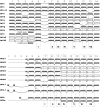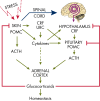Key role of CRF in the skin stress response system
- PMID: 23939821
- PMCID: PMC3857130
- DOI: 10.1210/er.2012-1092
Key role of CRF in the skin stress response system
Abstract
The discovery of corticotropin-releasing factor (CRF) or CRH defining the upper regulatory arm of the hypothalamic-pituitary-adrenal (HPA) axis, along with the identification of the corresponding receptors (CRFRs 1 and 2), represents a milestone in our understanding of central mechanisms regulating body and local homeostasis. We focused on the CRF-led signaling systems in the skin and offer a model for regulation of peripheral homeostasis based on the interaction of CRF and the structurally related urocortins with corresponding receptors and the resulting direct or indirect phenotypic effects that include regulation of epidermal barrier function, skin immune, pigmentary, adnexal, and dermal functions necessary to maintain local and systemic homeostasis. The regulatory modes of action include the classical CRF-led cutaneous equivalent of the central HPA axis, the expression and function of CRF and related peptides, and the stimulation of pro-opiomelanocortin peptides or cytokines. The key regulatory role is assigned to the CRFR-1α receptor, with other isoforms having modulatory effects. CRF can be released from sensory nerves and immune cells in response to emotional and environmental stressors. The expression sequence of peptides includes urocortin/CRF→pro-opiomelanocortin→ACTH, MSH, and β-endorphin. Expression of these peptides and of CRFR-1α is environmentally regulated, and their dysfunction can lead to skin and systemic diseases. Environmentally stressed skin can activate both the central and local HPA axis through either sensory nerves or humoral factors to turn on homeostatic responses counteracting cutaneous and systemic environmental damage. CRF and CRFR-1 may constitute novel targets through the use of specific agonists or antagonists, especially for therapy of skin diseases that worsen with stress, such as atopic dermatitis and psoriasis.
Figures














References
-
- Selye H. A syndrome produced by diverse noxious agents. Nature. 1936;138:32–33
-
- Selye H. The Stress of Life, revised ed New York, NY: McGraw-Hill Book Company; 1976
-
- Vale W, Spiess J, Rivier C, Rivier J. Characterization of a 41-residue ovine hypothalamic peptide that stimulates secretion of corticotropin and β-endorphin. Science. 1981;213:1394–1397 - PubMed
-
- Harris GW. Neural control of the pituitary gland. Physiol Rev. 1948;28:139–179 - PubMed
Publication types
MeSH terms
Substances
Grants and funding
- R01AR047079/AR/NIAMS NIH HHS/United States
- R01AR047652/AR/NIAMS NIH HHS/United States
- R01NS038326/NS/NINDS NIH HHS/United States
- P01 26741/PHS HHS/United States
- R01AR056666/AR/NIAMS NIH HHS/United States
- R01 AR047079/AR/NIAMS NIH HHS/United States
- R01AR052190/AR/NIAMS NIH HHS/United States
- R01DK065244/DK/NIDDK NIH HHS/United States
- R01 NS038326/NS/NINDS NIH HHS/United States
- R01 AR047652/AR/NIAMS NIH HHS/United States
- R01 AR056666/AR/NIAMS NIH HHS/United States
- R01 AR052190/AR/NIAMS NIH HHS/United States
LinkOut - more resources
Full Text Sources
Other Literature Sources

